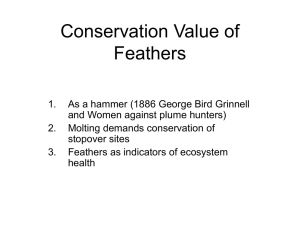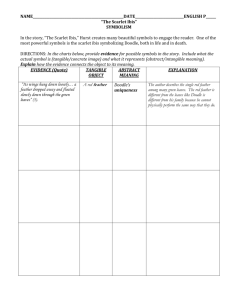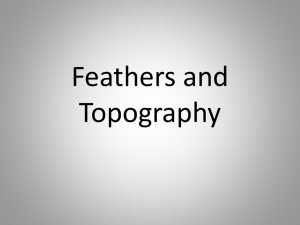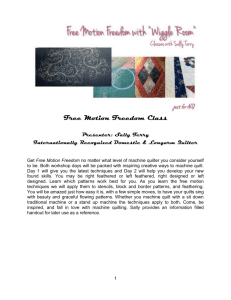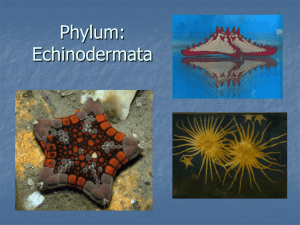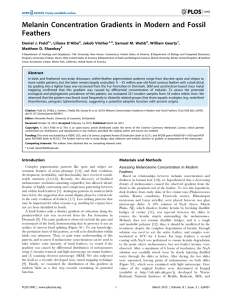Feather Color I
advertisement
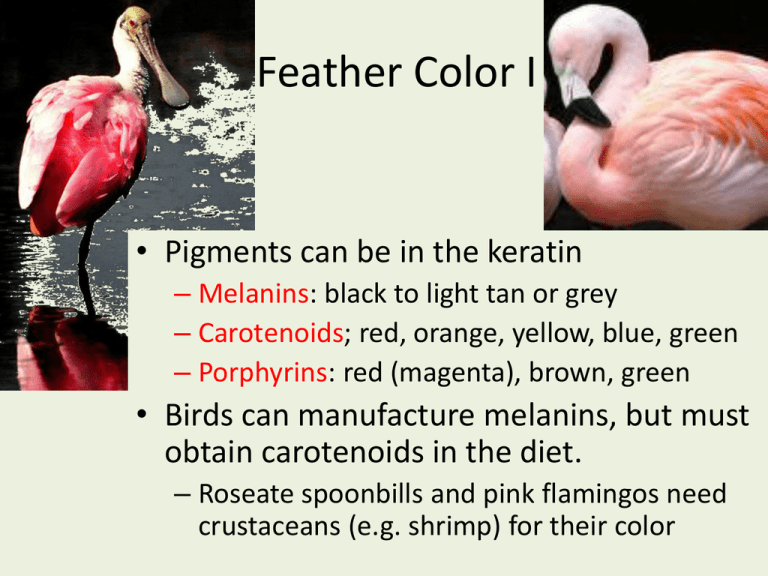
Feather Color I • Pigments can be in the keratin – Melanins: black to light tan or grey – Carotenoids; red, orange, yellow, blue, green – Porphyrins: red (magenta), brown, green • Birds can manufacture melanins, but must obtain carotenoids in the diet. – Roseate spoonbills and pink flamingos need crustaceans (e.g. shrimp) for their color Feather Color I (cont’d) • Except for albinos, all birds have some melanin • Melanocytes in the skin inject melanin into cells that become barbs and barbules • Intermittent deposition during feather development results in barring, speckling, other patterns • High melanin levels correlate with – wear resistance – bacterial degradation – drying damp feathers by concentrating radiant heat – Improved camouflage in many climates Feather Color I (cont’d) • Carotenoids in diet can accumulate in lipid (just as Vitamin A is lipid soluble in our bodies) in cells that become barbs and barbules • Porphyrins are related to hemoglobin and liver bile pigments. Unstable, so primarily seen in new feathers • Structure of the feather can provide iridescence – Blues, greens, purples, reds • Minute structures on the surface scatter or reflect particular wavelengths of light • Blues and white are usually structural • Green may be structural or pigment or both Blue Whistling-Thrush (Myiophonus caerulea) © Dr. Bakshi Jehangir - www.birdsofkashmir.com Feather Color II Ultraviolet Colors I • Ultraviolet structural colors can be produced by two types of structures. • Primarily iridescent colors are produced by arrays of melanin granules in feather barbules. – Those structural colors are created by coherent scattering, or constructive interference, of light waves scattered from the layers of melanin granules in barbules. – A few hummingbirds and European Starlings are known to produce UV hues with coherently scattering melanin arrays in feather barbules. Ultraviolet Colors II • The most commonly distributed UV hues, however, are structural colors produced by light scattering from the spongy medullary layer of feather barbs. – primarily UV hues have been documented in Chalcopsitta cockatoos (Psittacidae) and Myiophonus thrushes (Turdidae). – Extensively UV hues with a peak reflectance in the human-visible blue range have been observed in feather barbs of Blue Tits (Parus caeruleus), Bluethroats (Luscinia svecica), and Blue Grosbeak – Prum et al. (2003) have found extensive UV reflectance from apparently blue feather barbs in many families and orders of birds including motmots (Momotidae), manakins (Pipridae), cotingas (Cotingidae), fairy wrens (Maluridae), bluebirds (Sialia), buntings and others. • The structural UV hues of feather barbs, like other barb structural colors, are produced by the keratin / air matrix of the spongy medullary layer of the barb ramus – air bubbles. • However, the precise physical mechanism by which the humanvisible and UV barb colors are produced remains controversial. Bird Vision • Birds can discriminate UV colors • Feathers that may appear one color to us can be very different for a bird who sees the UV color, or patches of UV color • Two species that look identical to humans can be dramatically different under UV light (think of flowers with UV patterns for bees) Iridescence • http://people.eku.edu/ritchisong/554notes1.html • About 40% of the way down the page – Sapphire vented puffleg – Hummingbirds Patterns within feathers A) Representative patterns within feathers. (B) Some other basic patterns such as bars, circles, and spots. C) There are also, of course, color patterns at the level of the entire body (From: Yu et al. 2004). Genetic Control of Feather Color • Little is known about this topic in wild birds • Does appear to be genetic variation in some species • Some species have 2 or more distinct morphs Red tailed hawk Great blue heron Bird Skin and Eyes • Blues and greens in skin and eyes are found in many families • Size and spacing of parallel collagen fibers in skin Apteria & Feather Tracts • The spaces between feather tracts are a taxonomic character • Probably facilitate skin movement • May assist in heat loss during flight • Adjacent follicles are linked by numerous small muscles which facilitate movement • Variety of movements useful for display, thermoregulation, flight, buoyancy Abrasion plumage • As a bird ages through the year the tips of feathers may wear off, making the feather a different color on the end • Some birds, including many passerines, have drab or cryptic winter plumage which wears away leaving a brighter breeding plumage Snow bunting Motmot tail • Feather starts out as a typical tail feather but bird selectively preens the brittle portions away leaving the raquet shape Keel-billed Blue crowned Feather Care • Much grooming to maintain smooth shape, keep barbules aligned, apply wax, remove parasites • May groom every hour • Uropygial gland (preen gland), on lower back at base of tail, provides waxy secretion to: – clean feathers – keep them moist and flexible – improve insulation – maintain waterproofing and buoyancy Uropygial gland • • • • Waxes, fatty acids, fat and water Also helps regulate bacteria, fungi May discourage feather lice Foul-smelling waxes may repel mammalian predators Feather Parasites • Lice: chewing lice feed on feathers, blood and tissue fluids • Louse flies: flat bloodsucking flies; vectors of numerous blood parasites, can also transport lice and mites between hosts • Feather mites: numerous species with many niches including inside the shaft • Over 250 species are known to do anting • Active or passive • Ant may then be discarded or eaten • Pest control? Detoxifying food? • We don’t know Toxic Feathers • Some birds have toxins in skin and feathers – alkaloids in pitohui shrike-thrushes in New Guinea • Unknown whether they produce the poison or accumulate and sequester from their diet, as do Monarch butterflies from milkweed • Advantages?


